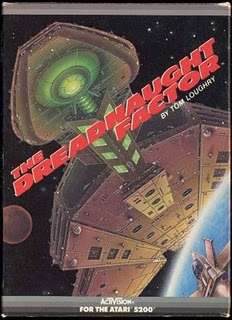The Dreadnaught Factor
| The Dreadnaught Factor | |
|---|---|
 | |
| Developer(s) | Activision |
| Publisher(s) | Activision |
| Designer(s) | Tom Loughry |
| Platform(s) |
Intellivision (original) Atari 5200, Atari 8-bit family |
| Release date(s) |
1983 (Intellivision) 1984 (Atari 8-bit, 5200) |
| Genre(s) | Shooter |
The Dreadnaught Factor is a video game written by Tom Loughry for the Mattel Intellivision and published by Activision in 1983.[1] Atari 5200 and Atari 8-bit family ports followed in 1984.
Gameplay
The game involved the player flying a small fighter spaceship to attack a very large and heavily armed vessel, a Dreadnaught. Each Dreadnaught approached the "Galactic Unstable Energy Field," which acted as a defensive line. The goal was to disable or destroy each Dreadnaught before it could reach the Energy Field and launch its missiles on the planets the player was entrusted with defending.
As the game progressed, the player could make repeated passes over the Dreadnaught, one fighter at a time, attempting to weaken its defenses, slow its progress, and finally destroy it. The fighter was equipped with lasers and bombs to attack different targets. Bombing the Dreadnaught's engines would slow its progress to the Field, and shooting out its bridges would reduce the Dreadnaught's ability to return fire from any intact gun turrets. In order to destroy the Dreadnaught, the player had to bomb all of its energy vents, causing the vessel to overheat and explode.
To defend itself against the player's fighter, the Dreadnaught could fire various types of cannon and missile launchers; these could be destroyed to prevent them from firing on future passes. If all of a Dreadnaught's missile silos were destroyed, it would pose no threat to the planet whether it reached the Field or not; however; the player would still have to destroy it before running out of fighters in order to advance in the game. As soon as a Dreadnaught was destroyed, another one of a different design would arrive and threaten the planet. The Dreadnaughts cane in five different designs, each of which posed its own challenges.
The game had various difficulty levels, ranging from "Basic" and "Novice" to "Expert" and finally, "You've Got to Be Kidding." The Dreadnaughts' speed, rate of fire, and fleet size increased at higher difficulty levels.
References
- ↑ "The GIant List of Classic Game Programmers". dadgum.com.